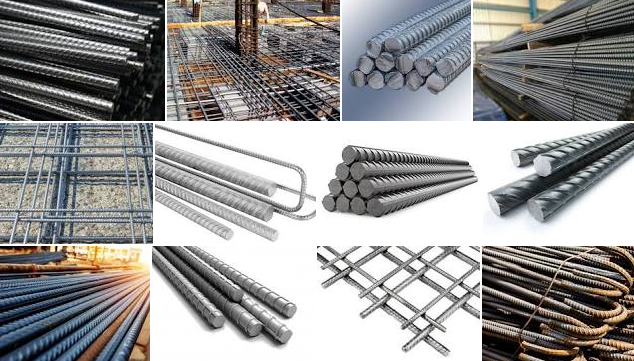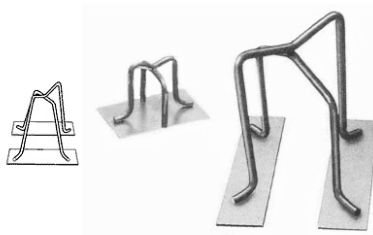1. Purpose
This Article is about specification of reinforcing steel and defines the minimum requirements for material, detailing, installation, and inspection of reinforcing steel.
2. Scope
The contractor shall provide all supervision, labor, materials, tools, equipment, and services necessary to detail, fabricate, deliver, and place steel reinforcement and bar supports according to the contract drawings and specifications.
3. RELATED DOCUMENTS
American Concrete Institute (ACI)
SP-66 Detailing Manual
318 Building Code Requirements for Structural Concrete
American Society for Testing and Materials (ASTM)
A 615/A 615M Specification for Deformed and Plain Carbon-Steel Bars for Concrete Reinforcement
A 996/A 996M Specification for Rail-Steel and Axle-Steel Deformed Bars for Concrete Reinforcement
A 1064/A 1064M Specification for Carbon-Steel Wire and Welded Wire, Plain and Deformed for Concrete
Concrete Reinforcing Steel Institute (CRSI)
Manual of Standard Practice
Wire Reinforcement Institute (WRI)
Welded Wire Fabric Manual of Standard Practice
4. MATERIALS AND PRODUCTS
4.1 General
4.1.1 Welded Wire Fabric. Rust, surface seams, or surface irregularities will not be cause for rejection provided the minimum dimensions, cross-sectional area, and tensile properties of a hand wire brushed test specimen are not less than specified in the ASTM specifications. Broken welds shall not be cause for rejection unless the number of broken welds exceeds the limits specified in the ASTM specifications.
4.1.2 Reinforcing Bars. Bars shall be free of detrimental surface imperfections. Rust, seams, surface irregularities, or mill scale shall not be cause for rejection, provided the weight, dimensions, cross-sectional area, and tension properties of a hand wire brushed test specimen are not less than specified in the ASTM specification.
4.1.3 Reinforcing bar sizes and welded fabric wire spacing and size shall be provided as stated on the contract drawings.
4.1.4 A certified copy of mill test on each heat of reinforcing steel delivered showing physical and chemical analysis shall be provided.
4.1.5 Material shall be protected from damage at the shop, in transit to the job site, during unloading and storage at the jobsite until inspection and acceptance by the company representative.
4.2 Steel Reinforcing Bars
4.2.1 Deformed reinforcing bars shall be Grade 60 (minimum yield strength of 60,000 psi), conforming to ASTM A 615 or A 996. Number 3 bars and larger shall be deformed. Bars shall be provided uncoated, e.g., not galvanized or epoxy coated.
4.2.2 Plain hot-rolled bars for spirals shall conform to ASTM A 615 or A 996, Grade 60.
4.2.3 Plain cold drawn steel wire, as drawn, for spirals shall conform to ASTM A 1064, with a minimum yield strength of 70,000 pounds per square inch (psi).

4.3 Steel Welded Wire Fabric
4.3.1 Plain steel welded wire fabric shall conform to the requirements of ASTM A 185. Wire used in the manufacture of welded wire fabrics shall conform to ASTM A 1064.

4.4 Wire Bar Supports
4.4. Bar supports shall conform to the specifications contained in Chapter 3 of the CRSI Manual of Standard Practice.
4.4.2 Bar supports that have ends that will not be exposed on the concrete surface shall be Type 1‑Class A-Bright Basic.
4.4.3 Bar supports that have ends that will be exposed on the concrete surface shall be Type 3‑Class C‑Plastic Protected.

4.5 Precast Concrete Block Supports
4.5.1 Precast concrete blocks shall be provided in three basic styles: (1) plain blocks, (2) blocks with two 16‑gauge tie wires, (3) blocks cast with a hole also known as dowel blocks.
4.5.2 Blocks three inches or larger shall contain nine sacks of cement per cubic yard and blocks smaller than three inches shall contain twelve sacks of cement per cubic yard. Proper curing shall be provided to attain a compressive strength of 6000 psi at time of use.

4.6 Tie Wire
4.6.1 The wire used shall be black annealed wire, 16 gauge or heavier.

5. REINFORCING BARS PROCEDURES
5.1 Detailing Reinforcing Materials
5.1.1 Detailing of concrete reinforcement shall be in conformance with the recommended methods, standards, and specifications contained in the ACI Detailing Manual, the ACI 318/318R Building Code Requirements for Reinforced Concrete and the CRSI Manual of Standard Practice.
5.1.2 The contractor shall provide reinforcing detail drawings, which shall consist of bar lists, schedules, bending details, placing details, and placing plans and elevations.
5.1.3 Reinforcing detail drawings, such as the placing drawings and lists, shall permit accurate fabrication and subsequent placement of the reinforcement materials.
5.1.4 The contractor shall submit reinforcing detail drawings for approval before fabrication as specified in Section 12.3 of 4WCE-600001.
5.2 Fabrication Procedure of Reinforcement Bars
5.2.1 All reinforcing bars shall be prefabricated accurately, on standard shop equipment, to the dimensions shown on the bending details to within the fabricating tolerances given in Part C of the ACI Detailing Manual SP-66.
5.2.2 Bars shall be bent cold and shall not be bent or straightened in a manner that will injure the material. Bars shall not be straightened and rebent more than once.
5.2.3 The minimum bend diameters and standard hook dimensions shall conform to the specifications given in the ACI Building Code.
5.2.4 Bars shall be securely tied together in “standard” bundles. Each bundle shall be tagged with a tag made of durable material and marked in a legible manner with waterproof markings, not less than one tag per bundle, attached by wire. Identification tags shall show the grade, number of pieces, size and mark or length of bars.
5.3 Placing Reinforcement Procedure
5.3.1 Reinforcement shall be accurately located in the forms within the tolerances and spacing limitations specified in the ACI Building Code, and shall be adequately supported and tied (including dowel bars) before the concrete is placed to prevent displacement during concrete placement operations.
5.3.2 Minimum concrete cover shall be provided for reinforcement as specified in the ACI Building Code.
5.3.3 Welding of crossing bars shall not be permitted for assembly of reinforcement.
5.3.4 Reinforcement partially embedded in concrete shall not be field bent, unless permitted by the company representative. Bars shall be bent only with a properly authorized bending device.
5.3.5 Splicing of reinforcing bars shall be made with a contact lap. The splice locations and development lengths shall be as shown on the company engineering drawings. Any additional splices that the contractor may require shall be detailed and submitted to company for approval.
5.3.6 Splicing of wire fabric shall be made according to the recommendations of the ACI Building Code.
5.3.7 Wire fabric shall be straightened to remove “set” or curvature from being rolled before placement in the forms. The curved side shall be placed up. Wire fabric shall be placed within the forms, supported on precast concrete blocks (or other approved supports) at 48‑inch centers and splices tied before placement of any concrete. The wire fabric shall be pulled upward during placement to maintain required cover.
5.3.8 The contractor shall provide bar supports of specified type, size, and in sufficient quantity to adequately support the reinforcement steel. The requirements of Chapter 3 of the CRSI Manual of Standard Practice shall govern placement of supports, unless otherwise indicated herein. Bar supports are not intended to and shall not be used for supporting hoses for concrete pumps, or runways for concrete buggies or similar construction loads.
5.3.9 Placing of bars on or into layers of fresh concrete as the work progresses and adjusting bars during the placing of concrete is strictly prohibited.
5.3.10 At the time concrete is placed, reinforcement shall be free from mud, oil, or other nonmetallic coatings that decrease bond. Any bar identification tags shall be removed. Any mud coating on the bars shall be washed off before using the bars. Contaminants such as form oil, machine oils, and grease shall be removed from the bars by cleaning with clean rags saturated with solvents that meet state or federal regulations. Soiled wipes shall be disposed of in a legal manner. The contractor shall review alternative cleaning methods with the company representative.

6. INSPECTION
At any place where fabrication and erection are carried on, any defective material or workmanship shall be corrected to the company representative’s satisfaction.
All materials and workmanship shall be subject to the inspection, examination, and approval of the company representative.